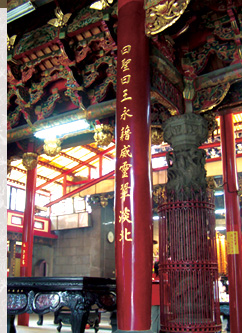layout | Double-eaved roof | Brackets | Symmetry
Architectural Features of Jing-Fu Temple-Symmetry
「Symmetry」refers to that a building is constructed by two or more teams of artisans and is separated into left and right portions which are symmetrical to each other by setting a middle axial line. Each team constructs one portion with their best arts to conduct competition and also labor division simultaneously.
The 「front-rear symmetry」in Jing-Fu Temple is rarely seen among Taiwan temples. The state chamber was designed by Chen, Ying-Pin and constructed by Chen, Chi-Yuen (his son). Front chamber (San-Chuan Chamber) was designed by Wu, Hai-Tung. Although each master did his best separately, each master’s features were integrated well to make Jing-Ful Temple demonstrating overall architectural harmony. The explanations are as in the following: |
The Comparisons on Brackets
The brackets in the State chamber and San-Chuan chamber are all composed of tiger holders brackets with which each tiger has its own distinctive posture that some tigers look back or overlook. The house eaves are all decorated with phoenix holders connecting with hanging sockets. The holders in the State Chamber designed by Artisan Chen are more bloated with tiger holders of abundant curves and stripes.
San-Chuan Chamber designed by Artisan Wu, Hai-Tung adopts more delicately and sophistically designed tiger holders. The tiger holders in the building frontage and internal shelf all demonstrate abundant postures linking with lotus holders. |

Left photo for bracket structure in the State Chamber
Painted by Hsu, I-Hung |
|

Right photo for bracket structure in the San-Chuan Chamber
Painted by Hsu, I-Hung |
|
| 2 photos above cited from 《Taoyuan Jing-Fu Temple—The Greatness Temple—Architectural Arts and History》 |

Bracket structure in State Chamber
(Photo by Chen, Mei-Chi)
|
|

Bracket Structure in San-Chuan Chamber
(Photo By Chiu, Hsien-Chang) |
|
Comparisons on Wooden Sea-Tortoise Holder

Wooden Sea-Tortoise Holders in the State Chamber |
|

Wooden Sea-Tortoise Holders in San-Chuan Chamber |
|
| 2 photos above cited from 《Taoyuan Jing-Fu Temple—The Greatness Temple—Architectural Arts and History》 |
Wooden holder is also called 「Insert Stick」、「Sparrow Connector」 and are usually located at the intersections of four gold pillars and beams and the major feature is a dragon-head with fish-body. The left photo shows the wooden holder in the State Chamber. The features completely different from that in San-Chuan Chamber include the fins and wings without jaws and flexibly curvy tail and two fins imitating swimming lively.
The right photo shows the wooden holders in San-Chuan Chamber of which the design of front jaws without fins is different from that in the State Chamber. Generally, sparkling dragon eyes and flying beard and gold body demonstrate beautiful and abundant color and luster and distinctive layer composition.
|
Comparisons on Hanging Flower Baskets

Hanging Flower Basket in State Chamber
Photo by Chen, Mei-Chi |
|

Hanging Flower Basket in San-Chuan Chamber
Photo by Chen, Mei-Chi |
|
Hanging basket is also called 「Hanging flowers」which is a short pillars hanging under beams to burden partial weight of roof by lever balance theory. The left photo shows the hanging flower brackets in the Staet Chamber and the right for San-Chuan Chamber each with its own distinctive features integrating with the whole architecture in accord. |
|





